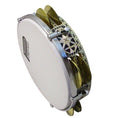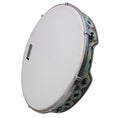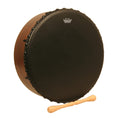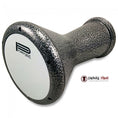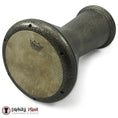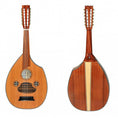- No products in the cart.
Mistakes you must avoid while playing a Darbuka
15
Jan
The most talented musicians are those who can learn from their failures. Throughout their life as musicians, people learn from their mistakes, whether they are little, simple errors while performing a particular piece.
Several basic errors might prevent your instrument from producing the deep, resonant 'boom' that we expect while playing a 'Doum' stroke on our Darbukas. Here are some frequent Doum errors to avoid making.
ERROR #1 - PALM NOT LANDING
Without your palm's support, the fingers lack support. As a result, you may end up hurting your fingers, causing your fingertips to bleed. In addition, you will not be able to make a decent, powerful sound with your Doum.
Therefore you must remember that the correct position of your palm is the key to playing the Doum properly since it enables powerful strikes. This guarantees that your palm falls firmly on Darbuka's metal head, allowing you to generate the best sound.
ERROR #2- PLAYING TOO MUCH IN THE MIDDLE
You might not be able to enjoy a boomy sound if you play toward the center of the skin. If you hit Darbuka's skin with your whole hand, including the palm, you may be setting yourself up for failure. Initially, this will produce a somewhat better sound than what you've been doing, but the fleshy portion of your hand will prevent the Doum from resonating since it has muffled the noises.
To get a clear idea of how the Doum is made, the vibrations of the skin create the sound waves transmitted through the drum's hollow part. If you place your hand on the skin of the Darbuka, the skin will vibrate less, and your Doum will start producing weaker sounds.
It would help if you generated as many vibrations as possible without striking too deeply into the instrument's center to ensure that your Darbuka has the correct sound. Ensure that your palm does not fall flat on the skin to generate the best sounds.
ERROR #3- NOT ENOUGH FINGER LANDING
This is common when individuals are not utilizing the correct hand posture while striking the Darbuka. If you use the tips of your fingers and not two whole phalanges, you will not be able to produce a loud sound. Instead of a deep and bassy Doum, the subsequent effect will create a sound that sounds like you're slapping your skin. Ensure that you place the precise areas of your fingers on the Darbuka to produce the correct Doum sound.
ERROR #4- NOT BOUNCING PROPERLY
Here, the bounce of the Doum may cause two problems:
The first difficulty is that you have no bounce, and your hand lands flat on Darbuka's skin. If your palm lands flat on the skin, you will prevent the skin from vibrating and produce a powerful Doum. To "push" the Doum through the drum's body, you must bounce your palm away from the skin after making contact.
The second problem is excessive bouncing and firm contact with the drum so that you can hear a high-pitched sound emanating from the Doum's overtones. This issue is caused by an extreme "striking" impact on the drum's metal part, which generates high-pitched overtones.
When striking the drum, you should land your fingers and palm, make contact with the drum, and then bounce your fingers away. This will cause the skin to vibrate appropriately, resulting in the Doum being "pushed" through the drum. By striking the Doum with excessive power and "attack," you will diminish its potency.
ERROR #5- IMPROPER SITTING POSITION
When deciding where to sit to play, practice, or perform, you should consider the amount of space behind your Darbuka. You need room behind your drum to enable the sound to travel, and you must ensure that no heavy fabrics or materials dampen the sound of your Darbuka. Consider your environment:
- You are seated on the floor in front of a couch.
- You seem to be sitting on a chair with a heavy curtain behind you.
- Are you reading this book on your laptop while sitting on your bed?
All these conditions will eliminate the bass from emanating throughout the room from the rear of your Darbuka. This is a typical issue faced by novices while practicing. The place they chose to practice is not conducive to sound transmission; as a result, their Darbuka will sound terrible even if they have the proper technique!
To resolve this condition, go to a spot where you are sure the circumstances are perfect for producing high-quality sound. The ideal ambient is a medium-sized room with hardwood or tiled flooring and most hard surfaces.
In a typical home, the kitchen (if it's large enough!) is the room with the finest acoustics (if it's large enough!). A sports hall, performance hall, or similar facility would be ideal outside the home. If unsure how well your Darbuka should sound, select a lovely place and try it! We are sure you will be startled by the acoustic differences between this location and your bedroom!
ERROR #6- POOR TUNING
Poor tuning may occur less often with the Doum than with other Darbuka strokes, but if your Darbuka is poorly tuned or of poor quality, your Doum may not boom effectively.
Here's a precise guide on how to tune your Darbuka properly!
Final Thoughts
We hope these techniques will help you improve the sound of your Darbuka, but keep in mind that you must undergo excellent ear training to ensure your Darbuka sounds great! Since music is an acoustic creative process, the most vital talent a musician can acquire is the capacity to listen. You may have the finest technique in the world and be able to play difficult musical sections, but your ears are the best indicator of whether or not the more minor elements of your playing are correct.
Enjoy some FREE DARBUKA LESSONS FROM DARBUKA PLANET!!








